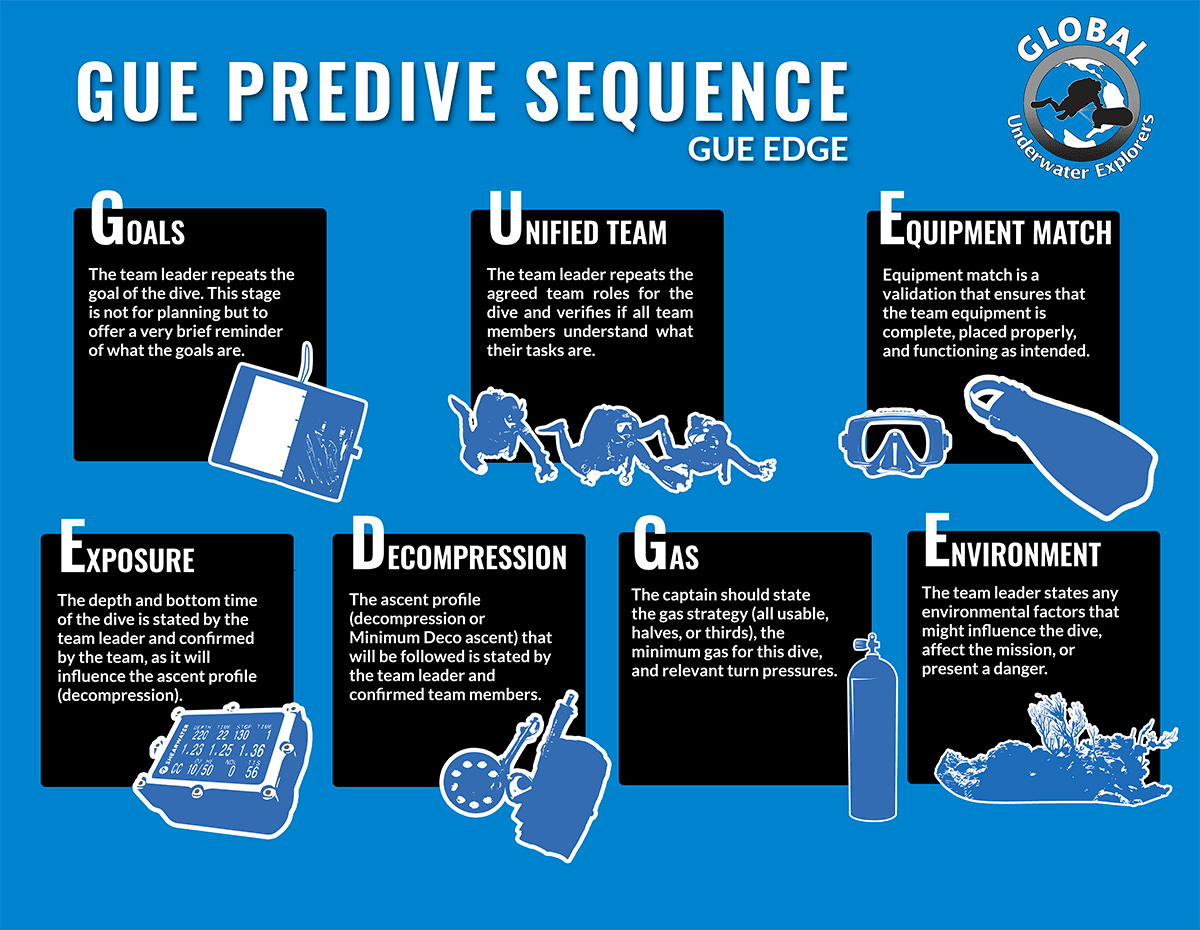GUE-EDGE Pre-Dive Planning:
The Most Effective Way To Do It
The most effective pre-dive sequence I have seen in action is GUE-EDGE, the dive planning checklist taught by Global Underwater Explorers (GUE). It is a structured pre-dive process designed to enhance safety, communication, and dive efficiency. Most divers who did not certify with GUE in their Open Water training first encounter it in a GUE Fundamentals class.
If you do not have a regular dive buddy who will agree to something this comprehensive, at least do something. GUE-EDGE is far superior to BWARF, but if you are not going to actually use it, then at least do BWARF. (See our Pre-Dive Checks guide for more on BWARF.)

GUE-EDGE Breakdown
- Goals (Objective, specific tasks)
- Unified Team (Roles, duties, formation)
- Equipment (Pre-dive check)
- Exposure (Time and depth limits)
- Decompression (Ascent profile)
- Gas (Minimum gas and strategy)
- Environment (Conditions, hazards, considerations)
Goals
What are we trying to accomplish?
Are we just getting in the water for a fun dive, taking a class, exploring a wreck, or doing a limited penetration into the wheelhouse? Are we planning to take photos?
Notice the we statements. This discussion can start with I want to... but should ultimately land on what we want as a team.
Unified Team
- Who is leading? Assign a Diver 1 and Diver 2 (or more if needed).
- Are we switching leaders at some point?
- Who is deploying the primary DSMB? Are we both carrying one?
- Who is managing the reel?
- Are we using the same hand signals, especially for gas pressure?
- What is our procedure for buddy separation?
- Who is managing the ascent and signals?
- Are you going to be generally on my left or my right?
Equipment
Make this a routine by always following the same order.
Example checklist: working top down and then right to left
- Mask ready? - Reach up and touch it
- Hood on? - Reach up and touch it
- Tank valve open? - Reach back and confirm
- Primary reg functional? - Take a few breaths
- Secondary reg functional? - Take a few breaths
- SPG secured? - Reach back and make sure, no need to check the pressure, we will do that later
- Computer on and ready?
- Primary light functional? - Turn on and off and stow
- Drysuit inflator functional? - Tap it
- BCD/Wing inflator functional? - Press it
- Backup light functional? - Turn on and off and stow
- Drysuit dump functional? - Twist it open
- BCD/Wing dump secured? - Reach back and check, no need to actually dump
- Compass secured? - Touch it and confirm
- Weights on belt secured? - Tug on them
- Cutting device on belt secured? - Touch it and confirm
- Waist belt snug and latched?
- Right pocket contains [blah]
- Left pocket contains [blah]
- Fins ready?
- Conduct modified S-Drill - Make sure all the hoses are routed correctly
Final step: Perform a Bubble Check before descending.
Exposure
- Planned max depth?
- Bottom time limit?
- Expected water temperature?
- Thermocline anticipated?
- Is everyone properly equipped for conditions?
Agreed Gas Plan
- Gas type? (Air, Nitrox 32, etc.)
- MOD for planned gas?
- Gas strategy? (See Recreational Gas Planning Guide)
- Turn pressure?
- Confirm starting gas before entry - Unclip the SPG, look at it and call out the pressure, re-stow
Environment
- Boat traffic?
- Marine life hazards? (Aggressive fish, fire coral, etc.)
- Expected condition of the wreck or site?
- Shore entry considerations? (Sand vs. rocks, waves, swell?)
- Downline or natural navigation?
GUE-EDGE is designed to be structured yet efficient, ensuring everyone is on the same page before the dive. It builds habits that improve safety and teamwork, especially when conditions become more challenging.
If you’re not diving with a team that follows this process, consider at least adopting the core principles for better pre-dive planning.